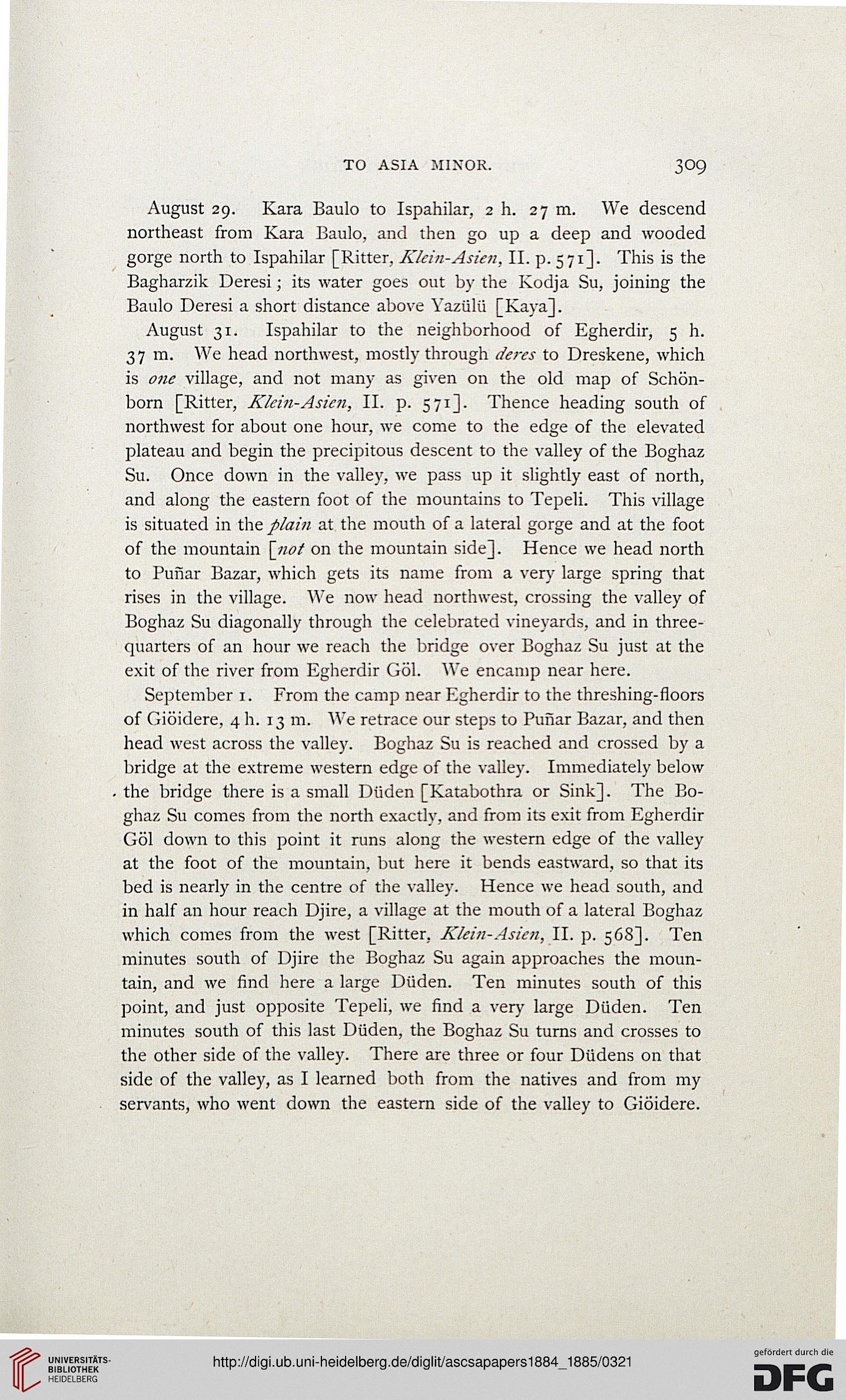TO ASIA MINOR.
309
August 29. Kara Baulo to Ispahilar, 2 h. 27 m. We descend
northeast from Kara Baulo, and then go up a deep and wooded
gorge north to Ispahilar [Ritter, Kkin-Asien, II. p. 571]. This is the
Bagharzik Deresi; its water goes out by the Kodja Su, joining the
Baulo Deresi a short distance above Yazulii [Kaya].
August 31. Ispahilar to the neighborhood of Egherdir, 5 h.
37 m. We head northwest, mostly through deres to Dreskene, which
is one village, and not many as given on the old map of Schon-
born [Ritter, Kkin-Asien, II. p. 571]. Thence heading south of
northwest for about one hour, we come to the edge of the elevated
plateau and begin the precipitous descent to the valley of the Boghaz
Su. Once down in the valley, we pass up it slightly east of north,
and along the eastern foot of the mountains to Tepeli. This village
is situated in the plain at the mouth of a lateral gorge and at the foot
of the mountain \_not on the mountain side]. Hence we head north
to Punar Bazar, which gets its name from a very large spring that
rises in the village. We now head northwest, crossing the valley of
Boghaz Su diagonally through the celebrated vineyards, and in three-
quarters of an hour we reach the bridge over Boghaz Su just at the
exit of the river from Egherdir G61. We encamp near here.
September 1. From the camp near Egherdir to the threshing-floors
of Gioidere, 4 h. 13 m. We retrace our steps to Punar Bazar, and then
head west across the valley. Boghaz Su is reached and crossed by a
bridge at the extreme western edge of the valley. Immediately below
the bridge there is a small Diiden [Katabothra or Sink]. The Bo-
ghaz Su comes from the north exactly, and from its exit from Egherdir
G61 down to this point it runs along the western edge of the valley
at the foot of the mountain, but here it bends eastward, so that its
bed is nearly in the centre of the valley. Hence we head south, and
in half an hour reach Djire, a village at the mouth of a lateral Boghaz
which comes from the west [Ritter, Kkin-Asien, II. p. 568]. Ten
minutes south of Djire the Boghaz Su again approaches the moun-
tain, and we find here a large Diiden. Ten minutes south of this
point, and just opposite Tepeli, we find a very large Diiden. Ten
minutes south of this last Diiden, the Boghaz Su turns and crosses to
the other side of the valley. There are three or four Diidens on that
side of the valley, as I learned both from the natives and from my
servants, who went down the eastern side of the valley to Gioidere.
309
August 29. Kara Baulo to Ispahilar, 2 h. 27 m. We descend
northeast from Kara Baulo, and then go up a deep and wooded
gorge north to Ispahilar [Ritter, Kkin-Asien, II. p. 571]. This is the
Bagharzik Deresi; its water goes out by the Kodja Su, joining the
Baulo Deresi a short distance above Yazulii [Kaya].
August 31. Ispahilar to the neighborhood of Egherdir, 5 h.
37 m. We head northwest, mostly through deres to Dreskene, which
is one village, and not many as given on the old map of Schon-
born [Ritter, Kkin-Asien, II. p. 571]. Thence heading south of
northwest for about one hour, we come to the edge of the elevated
plateau and begin the precipitous descent to the valley of the Boghaz
Su. Once down in the valley, we pass up it slightly east of north,
and along the eastern foot of the mountains to Tepeli. This village
is situated in the plain at the mouth of a lateral gorge and at the foot
of the mountain \_not on the mountain side]. Hence we head north
to Punar Bazar, which gets its name from a very large spring that
rises in the village. We now head northwest, crossing the valley of
Boghaz Su diagonally through the celebrated vineyards, and in three-
quarters of an hour we reach the bridge over Boghaz Su just at the
exit of the river from Egherdir G61. We encamp near here.
September 1. From the camp near Egherdir to the threshing-floors
of Gioidere, 4 h. 13 m. We retrace our steps to Punar Bazar, and then
head west across the valley. Boghaz Su is reached and crossed by a
bridge at the extreme western edge of the valley. Immediately below
the bridge there is a small Diiden [Katabothra or Sink]. The Bo-
ghaz Su comes from the north exactly, and from its exit from Egherdir
G61 down to this point it runs along the western edge of the valley
at the foot of the mountain, but here it bends eastward, so that its
bed is nearly in the centre of the valley. Hence we head south, and
in half an hour reach Djire, a village at the mouth of a lateral Boghaz
which comes from the west [Ritter, Kkin-Asien, II. p. 568]. Ten
minutes south of Djire the Boghaz Su again approaches the moun-
tain, and we find here a large Diiden. Ten minutes south of this
point, and just opposite Tepeli, we find a very large Diiden. Ten
minutes south of this last Diiden, the Boghaz Su turns and crosses to
the other side of the valley. There are three or four Diidens on that
side of the valley, as I learned both from the natives and from my
servants, who went down the eastern side of the valley to Gioidere.




